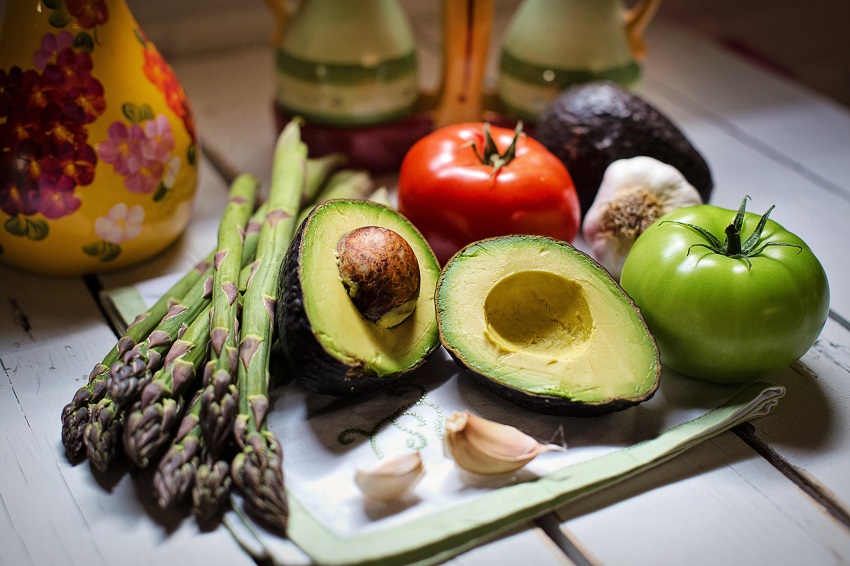Learning how to change your diet can feel overwhelming, especially if you are motivated by medical reasons. You can relax knowing that going plant-based is easy when you have helpful tools and resources to make the transition smoother.
To begin a more plant-based or vegan diet you will educate yourself on the types of foods you should include in your diet as well as those you should avoid. The transition will start with a smooth substitution of plant foods in dishes where you used to incorporate animal-based foods. As you grow more accustomed to the new improved dietary pattern, you will ultimately remove the use of vegan substitutions and simply enjoy an array of healthy whole plant foods.
This comprehensive guide will walk you step-by-step through all the necessary changes you are about to embark on given your decision to maximize your health and longevity through a plant-based diet.
Benefits of going plant-based
Researchers have documented the importance of adding more plants to your diet. In fact, the greater the amount of healthy plant-based foods you consume regularly, the less disease and illness you are likely to suffer from in your lifetime.
Studies have shown that plant-based vegan diets reduce the risk of acquiring the vast majority of America’s top killers, such as autoimmune disease, diabetes, hypertension, heart disease, obesity, certain cancers, liver and kidney disease, Alzheimer’s disease, and depression.
This does not simply apply to America alone, more and more countries are evolving to become more Westernized in terms of diet. And thus, more countries are acquiring these identical illnesses.
People who consume plant-based diets also have a greater likelihood of maintaining a healthy weight throughout their lifetime. This is not a fad diet, however. Formatting your diet this way is truly a lifestyle and a lifelong journey with much to learn along the way.
You will also find that you have more energy on this diet. I was able to completely remove caffeine from my daily routine within the first month of beginning my plant-based experience. My exercise regimen has greatly improved as a result of the energy improvements, as well.
You may also find that your sleep quality will greatly improve when eating healthy plant foods. It’s amazing what simple dietary changes can do for your circadian rhythms. I used to take sleeping pills religiously before stumbling upon this way of eating. I thankfully haven’t touched them in years!
Benefits beyond health & longevity
Some benefits of a plant-based diet that are unrelated to health include economical, environmental, and ethical aspects. Eating a diet consisting mostly of beans, potatoes, rice, lentils, and other whole grains tends to be very inexpensive. These are literally some of the cheapest items in the grocery store.
Eating less animals is also helpful for the environment for many reasons. Reducing commercial farming reduces the need to continue cutting down trees to grow animal feed, or house the animals themselves.
Reducing the amount of animals raised to be eaten by humans also reduces green house gasses produced by the animals and the the transportation required to supply the meat across the world. The amount of animal waste and farm run-off will also be reduced leaving our water supply and crops to be less polluted.
Lastly, although this is by no means of lowest importance, the cruelty down to these commercial raised animals will also be reduced. And that, my friends, is a wonderful feeling!

Plant-based variations
- Vegetarian: Vegetarians typically do not eat animal meat such as fish, beef, pork, or fowl. But they do consume animal products such as milk, cheese, and yogurt. They also consume a variety of processed and unprocessed plant foods.
- Vegan: On this diet people refrain from eating all animal products, such as milk, ice cream, meat, seafood, honey, butter, etc. People who follow a vegan diet typically do so for ethical or environmental reasons.
- Junk-food vegan diet: A vegan diet lacking in whole plant foods that relies heavily on mock meats and cheeses, fries, vegan desserts and other heavily processed vegan foods.
- Whole-foods plant-based (WFPB): Those who follow this diet also refrain from eating animal meat and animal products for health implications. They stick to a diet of whole, unrefined plant foods like potatoes and rice, while refraining from eating processed plant foods such as potato chips and soda.
- Whole-foods plant-based SOS-free: This diet follows the WFPB description above, while also focusing on refraining from consuming anything with added salt, sugar, or oil.
I have found the last variation of a plant-based diet to deliver the greatest health benefits. There is nothing wrong with any of the other variations, or any other way you choose to vary your dietary patterns. It’s just nice to have the facts from an unbiased sources before making any important decisions about your health and lifestyle.
The importance of whole foods
It is not enough to simply remove harmful foods from your diet, you must also replenish your body with high nutrient dense, whole foods. Some examples are whole potatoes, rice, carrots, and grapes.
Artificially rich foods can cause a number of problems when consumed on a regular basis. Similar to animal foods, processed food substances can cause problems with your body’s ability to respond to high blood sugar, as well as high blood pressure. These foods also lead to increased weight gain, obesity, skin disorders, neurological diseases, and mental disorders, among other things.
We were not designed to run on artificially engineered fuel. Every bite of processed food causes damage within the human body whether it be localized inflammation or endocrine disruption.
The video below provides a more in-depth look at some of the harmful effects of consuming artificial food dyes. Today, nearly all processed foods contain some amount of food dye, such as pickles, meat, salad dressing, mustard, yogurt, crackers, candy, and children’s breakfast cereal.
When sticking to whole foods your body is able to easily recognize each item and break it down at its slow, natural pace. As opposed to the fast, unwarranted absorption that follows artificial foods. Fast absorption rates correlate with spikes in insulin resistance and overall weight gain.
Take peanuts for example, when consumed in their whole, natural form they are slowly digested and may keep you full for hours longer than peanuts consumed in a less-natural form. Peanut-butter, on the other head is more readily taken into the bloodstream and delivered to your cells. You may absorb only about 80% of the total calories when digested whole, as opposed to 100% with easily digestible peanut-butter.
I’m not saying you should stress about not eating any convenience foods EVER. In our modern day, it’s completely impossible to not eat these processed foods to some extent. But you can, however, make a solid effort to choose these items seldomly, and in the healthiest form possible.
There are also many plant-based substitutes that don’t require a ton of food processing to provide the taste you are seeking. For instance, instead of refined sweetener, you can use dates or apple sauce to naturally sweeten your foods. Or instead of using salt, you can use vinegar, sodium-free soy sauce, or miso.
Setting a 30-day goal
Recognizing the importance of a healthy diet and taking actionable steps to get there is a great start. Now you must set an achievable goal for yourself that:
- You can see yourself achieving
- You believe it will better your life in some way
These are the two major factors involved in absolutely every form of behavioral change. If you can relate to each of these bullet points, then you are 100% ready to get started improving your diet through healthy plant-based nutrition.
I have found most success with my clients from setting a firm 30-day challenge. That is more than enough time to feel the dramatic impact of a plant-based diet on your health and well-being.
After you have reached your 30-day goal, I want you to tackle 90 days. At the 90-day mark, your taste buds will have nearly completely adapted to the natural flavors found in plant foods. From here, returning to your old eating habits are much more unlikely.
If 30-days is all you can tolerate, however, I’m still glad you gave it a shot. Change is not easy. And the dietary pattern we grew up with tends to resonate with us to our very core. It takes time and perseverance, but I assure you, this is well worth the effort!
Clarify & acknowledge your motivations
Remember your “why”. Why do you want to do this? Is it because you want to see your grand-kids grow up, or to improve your physical fitness? Or perhaps you are undertaking this dietary challenge to reduce your medical bills or get off your medications. Maybe you are just plain sick of feeling like crap all the time!
Whatever your reason, figure out exactly why you want to do this and keep that in your forefront. It’ll come in handy at the end of those busy work-weeks when you think a greasy cheeseburger will solve all your problems… or whatever your vice may be.
Letting go of dietary myths & misconceptions

The food industry has done a fantastic job of keeping us utterly clueless about what we are supposed to be eating. There is no money in REAL health food because it is perishable.
So what do the billion dollar food companies do? They fund studies that will result in shotty claims about how we “need” milk for strong bones, and olive oil for heart health, and animal protein for strong muscles, and fish for omega-3s, and so on and so forth.
“Milk is required for calcium”
Let’s first take a look at milk. For as long as I can remember, people have been concerned about my bone mineral density because I have never been able to stomach the taste of milk. As it turns out, epidemiological studies have shown that countries with the highest consumption of milk and other dairy products actually have the highest rates of bone fractures.
Where do you think the cows get all their calcium? That’s right, plants! Why drink antibiotic, hormone, fecal, and pus contaminated animal milks when you can get your minerals directly from the source?
Some great plant-based sources of calcium are green leafy vegetables, broccoli, tofu, tempeh, tahini, almonds, black beans, vegetarian baked beans, oranges, seeds, and blackstrap molasses.
I spent a lot of time researching the harmful effects consuming dairy products. For more information you can visit my post titled Is it Really Healthy or Safe to Feed Your Baby Cow’s Milk?
“Dietary oil is needed for heart-healthy omegas”
Let’s begin with the olive oil claim: Studies that are NOT funded by the olive companies actually show an overwhelming amount of evidence that olive oil is not only NOT protective against heart disease, but it actually accelerates it.
This is why cardiac patients are instructed to eat minimal added dietary fats. Olive oil, as well as every other oil is 100% fat. No carbs, no protein, no fiber, and no micronutrients. Just pure liquid fat.
“Meat is necessary for iron and protein”
The public has been led to believe that meat is necessary to consume for iron and its “superior protein” (as compared to plants). Fortunately for those who would rather not consume harmful saturated fats, trans fats, and cholesterol from meat, plants provide all the iron and protein you could possibly need.
Iron
The iron found in meat is called heme-iron. This form is actually harder on our system than normal iron.
One of the problems with heme iron is that it can convert less reactive oxidants into highly reactive free radicals. And free radicals can damage different cell structures like proteins, membranes, and DNA. Good plant sources are lentils, chickpeas, beans, tofu, flax seed, and cashews.
Protein
Animal protein is also greatly damaging when consumed on a regular basis. It has been shown to promote a variety of cancers from liver cancer to pancreatic cancer.
Consuming animal protein also results in us having higher circulating levels of trimethylamine N-oxide (TMAO).
TMAO is a substance that injures the lining of our vessels, creates inflammation, and facilitates the formation of cholesterol plaques in our blood vessels. And that, of course, is highly problematic for cardiovascular health.
Plant protein is not only safer, but more efficient than ingesting animal proteins. Some plant foods high in protein are quinoa, oats, lentils, beans, tempeh, tofu, nuts, and seeds.
“Fish is needed for Omega-3s”
This claim is similar to the dairy claim, by which fish do not make DHA, they acquire it from sea plants. And we can too!
You can acquire all the omega-3s necessary for brain health and other important bodily functions from plant sources such as algae, flax seeds, walnuts, edamame, hemp seeds, chia seeds, and soybeans.
Obtaining your healthy fats from plants instead of marine animals allows you to gain all the benefits without the risks. Fish are the most heavily polluted creatures on the planet right now. By ingesting them you will undoubtedly be ingesting heavy metals such as mercury, and environmental contaminants such as PCBs.
Mercury poisoning has been known to cause nervous system disorders and reproductive issues as well as developmental problems in children and unborn babies.
Step 1 Ideation stage: Familiarize yourself with plant-based substitutes
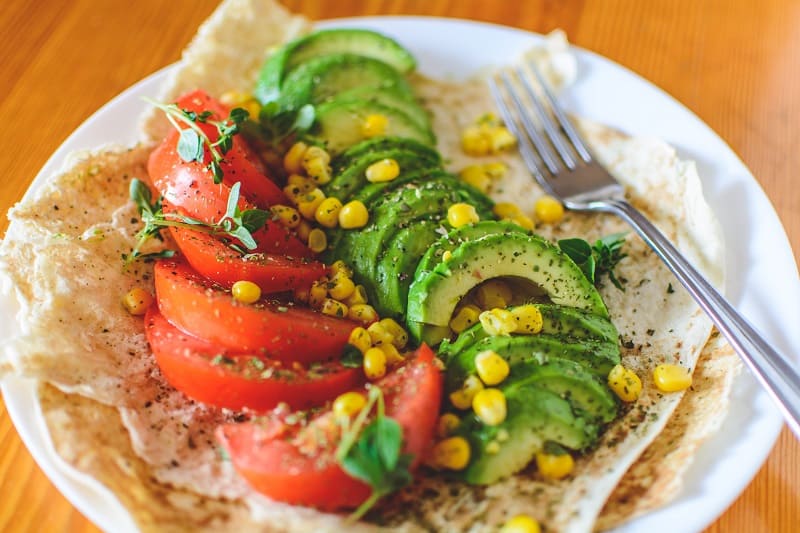
I have to credit Dr. Barnard for this section. He advises his patients to spend the first 7-days prior to going plant-based just contemplating which items could be used in place of the more familiar animal-based or highly processed foods.
For instance, instead of a chicken burrito you can have a black bean and rice burrito. Instead of beef stir fry maybe you have tofu or edamame stir fry. And instead of chocolate pie for desert, you decide you with have a bowl of fresh berries.
Practice this for a whole week before diving in to your plant-based journey. By the time you get to the end of the week you should have your vegan starter grocery list ready to go. I will be covering the grocery list items more in-depth below with a full printable example.
Step 2 Clean up your home environment
During the ideation stage, take some time to clean any animal products and processed junk out of your kitchen. Keep in mind that this will require the support of family members. During the next 30-days it is crucial that everyone in the household keeps the environment free of harmful foods that may be detrimental to your goals.
Remove all harmful items from the freezer, fridge, cupboards, candy dishes, and pantry. This is by far the most important step. So don’t be tempted to skip it with rationalizations of holding onto pseudo-foods because you don’t want to “waste money”.
When in all actuality, throwing out these foods will allow you to save money in the long term. Harmful foods put you at high risk for serious medical bills in your not-so-distant future. It’s best to set your standards high right from the beginning. This way, you will have a much higher likelihood of succeeding. As Chef AJ always says:
“If it’s in your house, it’s in your mouth!”
Chef AJ
Don’t worry! Your cupboards won’t be bare for long. Before the first day of week one you need to have your Week 1 grocery shopping complete, and the majority of your weekly meals prepped and ready to go. You will find more information on these steps below.
Step 3 Social support
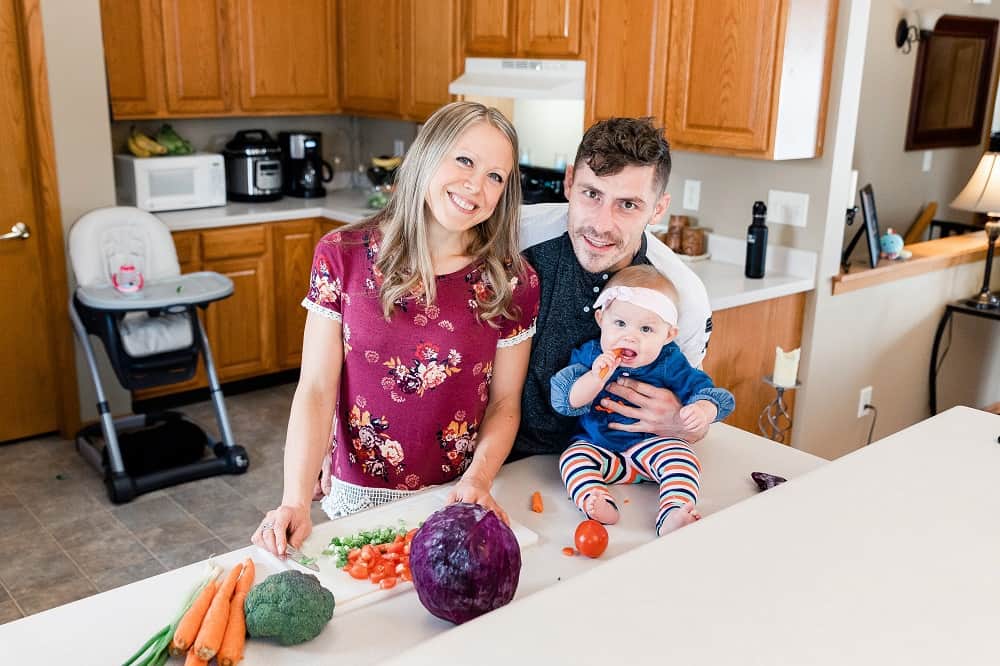
Gaining the support of friends and family will increase your chances of success in obtaining a healthy plant-based lifestyle. It is particularly crucial that those you live with are susceptible to making some adjustments to improve the shared environment.
For instance, getting everyone on board with this diet would be ideal. Particularly in the initial 30 days of the process. Sit down with your loved ones and express your desire to make some healthful changes, such as removing the junk food and focusing on healthier meal options.
Develop a weekly menu together with different plant-based meals. If they are reluctant simply give them a choice between two cuisines and adapt their favorite choices to have plant-based items. For instance, if their favorite foods are mac & cheese and pizza, let them choose between they two and then substitute the harmful ingredients for healthier items.
For mac & cheese use a whole grain pasta with nutritional yeast. And for pizza just remove the cheese and use a whole grain pizza crust. Top it off with lots of veggies.
Most common plant-based pitfall
I must provide a word of caution regarding this substitution strategy, however. This is only something I recommend during the transition stage.
When first learning how to eat plant-based, it can be tempting to simply swap out all your unhealthy foods with vegan substitutes. But most of these substitutions can be just as unhealthy, if not worse than the original food item. Everybody makes this mistake in the beginning!
The more sustainable strategy is to fully embrace plant foods in their most natural form. This would likely exclude the pizza crust and noodles.
Does this mean you can never make the healthier versions of mac & cheese and pizza described above? No. It just means the majority of your family’s meals should come from whole food sources like potatoes, rice, lentils, and corn.
Strategies for stubborn family members
Lastly, If some family members are completely unwilling to adjust their habits, perhaps they will agree to keep all junk food out of the house. If they want to eat these toxic foods, they will need to do it outside the home.
Perhaps it is your children who are unwilling to make changes. Just remember that you provide the groceries. If you do not purchase harmful foods, your kids will not have the option of consuming them in the household.
This may seem drastic for some, but it really shouldn’t. If you know these foods are causing you to feel ill and unhappy why would you want to feed them to your kids?

Meal prep
Meal prepping may seem overwhelming and time-consuming at first, but after you insert it into your weekly routine it will come very easy and efficient to you. This will take all the guessing and anxiety out of your meals.
At the beginning of every week you will take some time to plan out each of your meals and chop, cook, or mix anything that can be prepared ahead of time.
Don’t over-complicate this! Don’t make some extraordinary recipe with 15 separate ingredients that you’ve never heard of. Stick to the basics. Your meals should consist of vegetable soups, salads, and starches complimented by fruits and veggies.
If you work during the week be sure to have your grocery shopping done for the upcoming week by Friday or Saturday. Then you will have all day Sunday for the actual cooking and preparing of meals into individualized serving containers.
If your work schedule is not the usual Monday through Friday gig, adjust your prepping accordingly. You may have to freeze some meals if your work-week is all over the place, or variable from week to week.
Again, this just takes a little forethought. Everything on your grocery list should coincide with the exact foods you will be preparing for each meal of any given week. If you have the luxury of shopping twice per week that’s fine too. You can always split up your grocery trips if you have the time.
I have included a sample list below if you are looking for some ideas.
When it comes to planning out your meals, start with what you know to make the transition smoother. If you are well-versed with pastas, salads, and stir frys, then stick to those foods until you are comfortable branching out.
If you choose to eat nothing but broccoli and brown rice for the first 30 days, well that’s fine too. I eat the same two to three meals just about everyday with slight variations here and there. For instance, instead of a sweet potato I may substitute with squash, or instead of putting fresh berries on my oatmeal I may use apples with cinnamon.
My personal meal prep strategy
Every Sunday, I usually chop three large containers of fresh veggies to be eaten raw with hummus, to be steamed, or even to be thrown into stews or soups. By the end of each week the containers are always empty.
I also make a massive salad with different types of greens, sprouts, and colorful veggies every week. To go with the salad, I also make a large mason jar full of homemade dressing. This will suffice as my lunches during the week.
Lastly, I make a huge supply of starch and beans. This may consist of jasmine rice and edamame, sweet potatoes and kidney beans, brown rice and black beans, or squash and pinto beans.
You can switch up the starches and the legumes anyway you like, but these should be the major focus of your meals and your daily calories.
Make one of your daily meals a large colorful salad. This will ensure you are receiving adequate micronutrients from your diet. You can add a starch-based soup, baked potato, beans, and/or rice to your salad to keep you satiated and provide more calories if you need them.
It’s difficult to obtain an adequate number of calories from eating salad alone. This is why they are so useful for maintaining your weight year after year.
Below is a helpful graphic displaying the basic distribution of vegan calories you should generally obtain throughout a given day. The diagram is courtesy of Brenda Davis R.D.
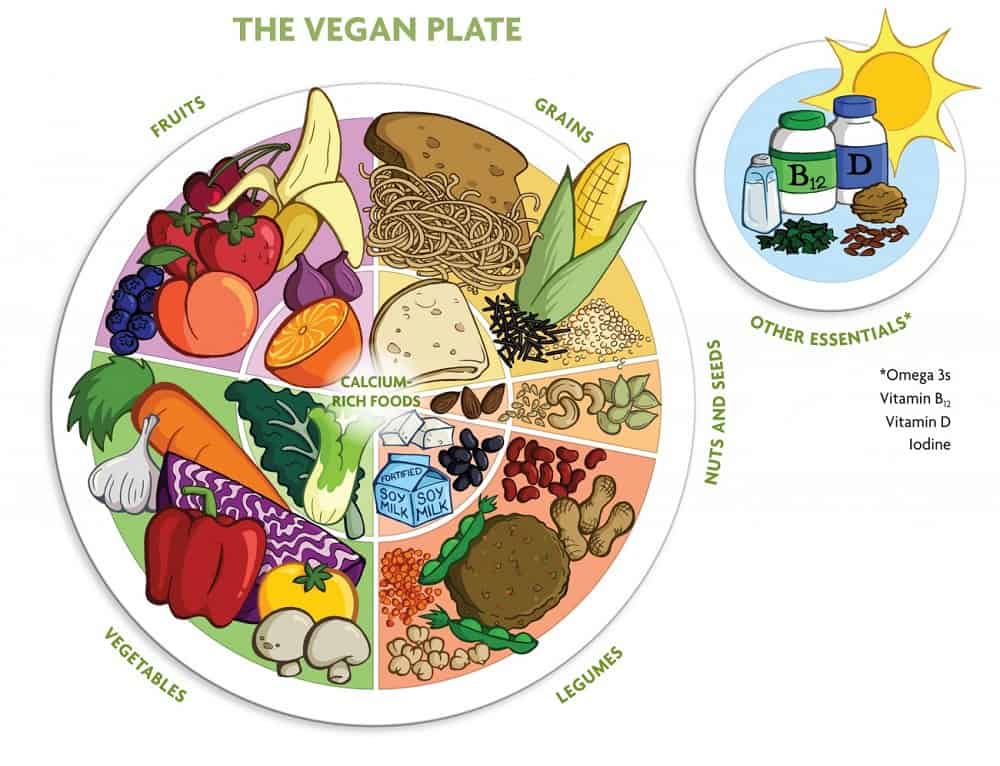
Sample 7 day starter meal plan
Click on the downloadable starter meal plan above to get an idea of what your meals and snacks might look like. You can follow each meal as I have it written, you can mix and match items, or you can completely do your own thing. My aim is to provide you with a general layout to help you succeed in your plant-based endeavor.
Supplements to consider
Vitamin B12
The most essential supplement you will require when switching to a carnivorous diet to a plant-based vegan diet is vitamin B12. This vitamin doesn’t inherently come from animals, it is made by microorganisms in the soil and is thereby eaten by the animals then housed in their flesh. This is why carnivores tend to get somewhat higher B12 levels than herbivores.
Prior to the development of modern sanitation systems we used to obtain plenty of B12 naturally from drinking out of streams and eating unwashed fruits and veggies. Today, we can obtain our B12 from animal products or plant foods such as fortified nut milks, nutritional yeast, and fortified cereals.
It is incredibly difficult to obtain sufficient amounts of B12 from today’s dietary sources alone, however. This is why both vegans and meat-eaters should consume a 50 mcg supplement of B12 daily, or 1,000 mcg weekly.
B12 is essential for brain function, maintenance, and development. It also helps to keep the body’s nerve and blood cells healthy and helps make DNA, the genetic material in all cells. Without adequate amounts you could suffer from megaloblastic anemia, nerve problems, constipation, weakness, depression, confusion, dementia, and memory problems.
Other supplements that I take regularly, and highly recommend for anyone on a plant-based diet are vitamin D and iodine.
Vitamin D
Vitamin D is obtained from exposure to sunlight. Most of us, however, spend most of our time indoors and are unable to get adequate amounts of sunlight to reach our daily requirements. 1000–4000 IU (25–100 micrograms) is needed to maintain optimal blood levels.
Iodine
Iodine is commonly found in sea vegetable and iodized salt. If you are consuming an SOS-free diet, I recommend taking a daily 150 mcg supplement to meet your daily requirements. This mineral is important for proper thyroid function.
Dining out at restaurants
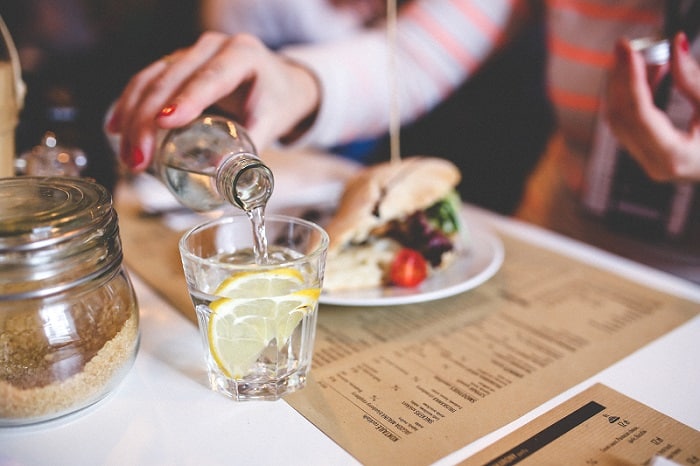
Dining out as a plant-based vegan, or any other variety of diet, has become easier than you might think. Restaurants and even fast-food joints are trying to accommodate for the demands of their plant-based customers.
Many places will have vegan substitutions available for those interested. You can always call ahead if you want the guarantee prior to committing to a particular restaurant.
If you are eating SOS-free, you will just have to accept the fact that any time you eat outside of your home you will most likely be consuming salt, sugar, and oil.
I dine out as little as humanly possible. The food just doesn’t taste right after consuming whole plant foods long enough. The items are typically over-cooked, have been sitting under heat lamps for extended periods, and tend to be loaded with salt, sugar, and oil.
I tend to eat prior to dining out so I won’t be tempted to overindulge on heavy calorie-dense restaurant food. My family has gotten used to it. And within time, your family will learn to accept your decisions to improve your health also.
Attending social gatherings
Social get-togethers can be a little awkward when transitioning to a new diet at first. But as soon as your friends and family catch on to your commitment to maintain healthful dietary habits, most people will support your decision and move on. Others may insist you continue eating meat and dairy products to fulfill their well-meaning but misguided beliefs that these foods are necessary for adequate human health.
Be patient with these individuals, as they may not be aware that most of their dietary beliefs are built solely upon successful marketing ploys. Just provide a good example with your due diligence to your 30-day commitment, and ensure them that you have done your research.
I also find it helpful to bring a plant-based dish to every gathering so I know I will have something to eat. A simple fruit or veggie tray is always welcomed. And as with dining out, it is also helpful here to eat prior to attending the get-together. That way you are not starving and therefore more likely to stick to your diet plan.
Disclaimer
If you are currently taking medication for high blood pressure, diabetes, thyroid disorder, or other medical ailments please let your doctor know you are starting a plant-based diet and have them check your medication levels after the first week or two on the diet. This is not a recommendation, this is critical because you will likely need to have these medications reduced or removed altogether.
If you have any questions, feel free to leave them in the comments below or message me directly at info@modernnutritiondesigns.com.
Karli Jackson

